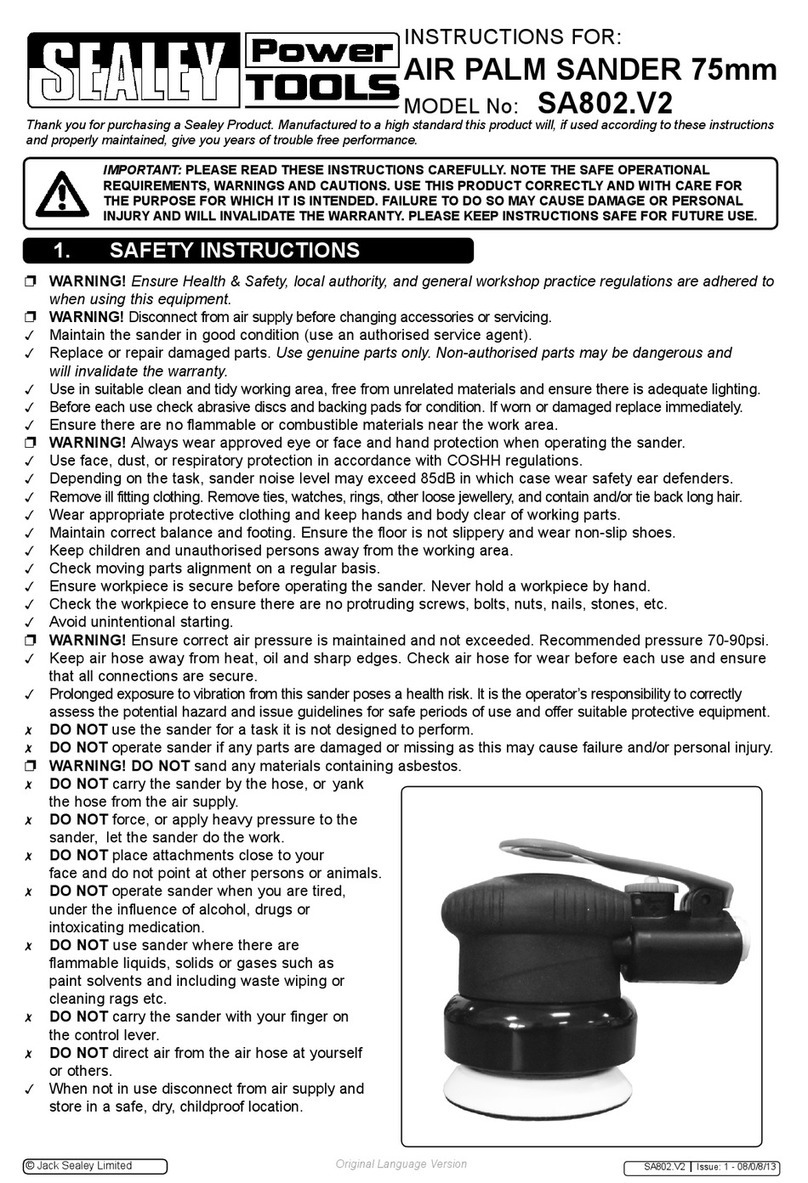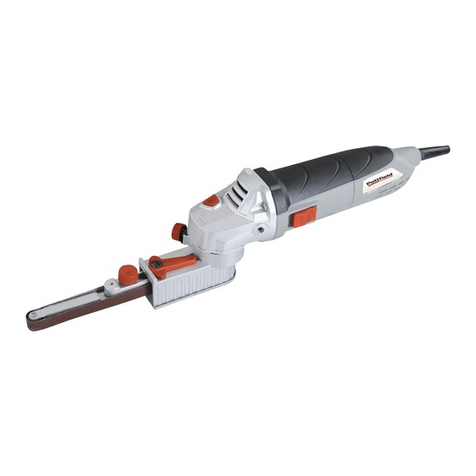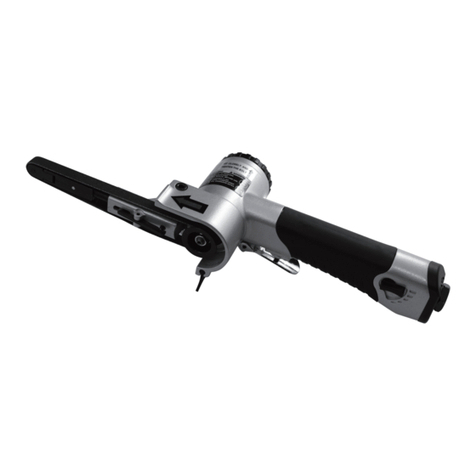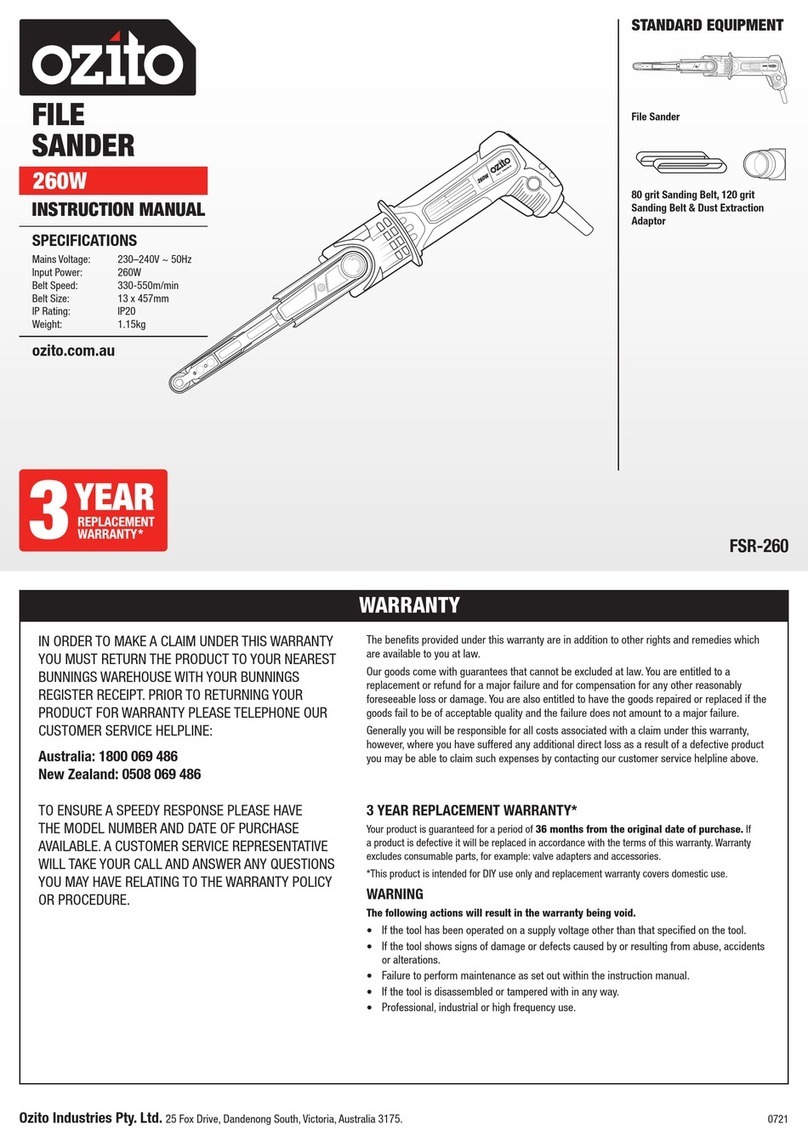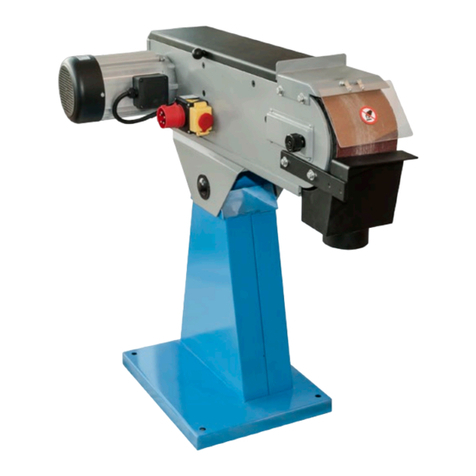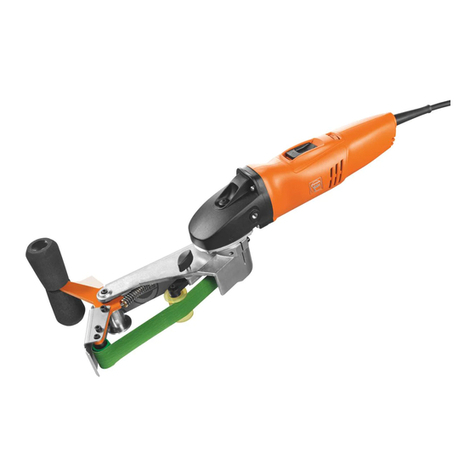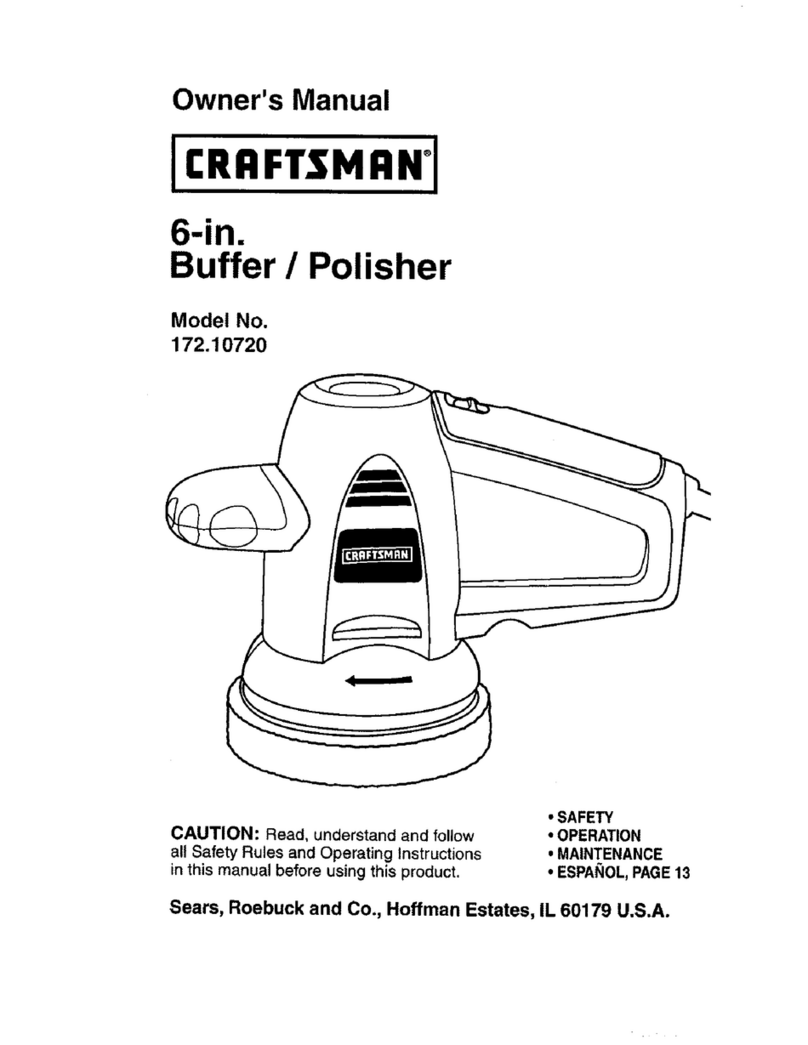siegen power S01046 User manual

Thank you for purchasing a Sealey Product. Manufactured to a high standard this product will, if used according to these instructions
and properly maintained, give you years of trouble free performance.
IMPORTANT: PLEASE READ THESE INSTRUCTIONS CAREFULLY. NOTE THE SAFE OPERATIONAL REQUIREMENTS,
WARNINGS AND CAUTIONS. USE THIS PRODUCT CORRECTLY AND WITH CARE FOR THE PURPOSE FOR WHICH
IT IS INTENDED. FAILURE TO DO SO MAY CAUSE DAMAGE AND/OR PERSONAL INJURY AND WILL INVALIDATE
THE WARRANTY. PLEASE KEEP INSTRUCTIONS SAFE FOR FUTURE USE.
WARNING! Ensure Health & Safety, local authority, and general workshop practice regulations are adhered
to when using this equipment.
WARNING!Disconnect from air supply before changing accessories or servicing.
Maintain the sander in good condition (use an authorised service agent).
Replace or repair damaged parts. Use genuine parts only. Unauthorised parts may be dangerous and
will invalidate the warranty.
Use in suitable clean and tidy working area, free from unrelated materials and ensure there is adequate lighting.
Before each use check abrasive belt for condition. If worn or damaged replace immediately.
Use only the correct size and type of sanding belt with this sander.
Ensure there are no flammable or combustible materials near the work area.
WARNING! Always wear approved eye or face and hand protection when operating the sander.
Use face, dust, or respiratory protection in accordance with COSHH regulations.
Depending on the task, sander noise level may exceed 85dB, in which case wear safety ear defenders.
Remove ill fitting clothing. Remove ties, watches, rings, other loose jewellery and contain and/or tie back
long hair.
Wear appropriate protective clothing and keep hands and body clear of working parts.
Maintain correct balance and footing. Ensure the floor is not slippery and wear non-slip shoes.
Keep children and unauthorised persons away from the work area.
Check moving parts alignment on a regular basis.
Ensure workpiece is secure before operating the sander. Never hold a workpiece by hand.
Check the workpiece to ensure there are no protruding screws, bolts, nuts, nails, rivets, etc.
Avoid unintentional starting.
WARNING! Ensure correct air pressure is maintained and not exceeded. Recommended pressure 70-90psi.
Keep air hose away from heat, oil and sharp edges. Check air hose for wear before each use and ensure
that all connections are secure.
Prolonged exposure to vibration from this sander poses a health risk. It is the owner’s responsibility to
correctly assess the potential hazard and issue guidelines for safe periods of use and offer suitable
protective equipment.
DO NOT use the sander for a task it is not designed to perform.
DO NOT operate sander if any parts are damaged or missing as this may cause failure and/or personal injury.
WARNING! DO NOT sand any materials containing asbestos.
DO NOT carry the sander by the hose, or yank the hose from the air supply.
DO NOT force, or apply heavy pressure to, the sander, let the sander do the work.
DO NOT switch the sander on whilst the belt is in contact with the workpiece.
DO NOT operate sander when you are tired or under the influence of alcohol, drugs or intoxicating
medication.
DO NOT use sander where there are flammable liquids, solids or gases such as paint solvents and including
waste wiping or cleaning rags etc.
DO NOT carry the sander with your finger on the power lever.
DO NOT direct air from the air hose at yourself or others.
When not in use disconnect from air supply and store in a safe, dry, childproof location.
1. SAFETY INSTRUCTIONS
2. INTRODUCTION & SPECIFICATION
Original Language Version S01046 Issue: 1 - 15/03/13
Aluminium housing with articulated sanding arm. Features belt tracking control, heavy-duty nose roller and
one-handed trigger operation. Suitable for sanding otherwise inaccessible areas such as around door-shuts.
Supplied with three belts. Replacement belts readily available. Ideal for the DIY enthusiast and light garage use.
© Jack Sealey Limited
INSTRUCTION MANUAL
AIR BELT SANDER
10 x 330mm
MODEL NO.
S01046

3.1. Air Supply
Recommended hook-up procedure is shown in fig.1.
3.1.1. Ensure the sander air valve (or throttle) is in the "off" position before connecting to the air supply.
3.1.2. You will require an air pressure between 70-90psi, and an air flow of 7cfm.
3.1.3. WARNING! Ensure the air supply is clean and does not exceed 90psi.
Too high an air pressure and unclean air will shorten the product life due to excessive wear, and may be
dangerous causing damage and/or personal injury.
3.1.4. Drain the air tank daily. Water in the air line will damage the sander and will invalidate your warranty.
3.1.5. Clean compressor air inlet filter weekly.
3.1.6. Line pressure should be increased to compensate for unusually long air hoses (over 8 metres).
The minimum hose size should be 1/4” I.D. and fittings must have the same inside dimensions.
3.1.7. Keep hoses away from heat, oil and sharp edges. Check hoses for wear, and make certain that all
connections are secure.
3.2. Couplings.
Vibration may cause failure if a quick change coupling is connected directly to the air sander. To overcome this,
connect a leader hose to the sander. A quick change coupling may then be used to connect the leader hose to
the air line recoil hose. See figs.1 & 2.
LEAD PAINT WARNING!
Paint once contained lead as a traditional ingredient. The dust from the removal of such paint is toxic if
ingested/inhaled and must, therefore, be avoided. The following actions must be taken before using the
sander on a surface that you suspect may contain lead paint.
1. User must determine potential hazard relating to age of paint to be removed.
(Modern paints do not have lead content).
2. DANGER! Keep all persons and pets away from the work area. The following persons are
particularly vulnerable to the effects of lead paint dust: Expectant women, babies and children.
3. We recommend personal protection by using the following safety items:
a) Paint Spray Respirator (Sealey ref. SSP1699)
b) PE Coated Hooded Coverall (Sealey ref. SSP265-L).
c) Latex Gloves (Sealey ref.SSP24).
4. Take adequate measures to contain the paint dust, flakes and scrapings.
5. Continue to wear safety equipment as in (3) above and thoroughly clean all areas when task is
complete. Ensure paint waste is disposed of in sealed bags or containers and according to local
Authority guidelines.
3. PREPARING FOR USE
fig.1
fig.2
Original Language Version S01046 Issue: 1 - 15/03/13
© Jack Sealey Limited
Specification
Model No: ................................................. S01046
Air Pressure:.................................................. 90psi
Air Consumption:............................................7cfm
Air inlet: .................................................... 1/4”BSP
Weight: ..........................................................0.8kg
Noise pressure level:................................ 79.4dBA
Noise power level:.................................... 90.4dBA
Vibration level:............................................1.1m/s²
Uncertainty value(k) .................................0.13m/s²

WARNING!Disconnect sander from air supply before changing accessories, servicing or performing
maintenance.Replace or repair damaged parts. Use genuine parts only. Unauthorised parts may be
dangerous and will invalidate the warranty.
5.1. If the air supply system does not have an oiler lubricate the sander daily with a few drops of a good
grade air tool oil, such as Sealey ATO/500 or ATO/1000, dripped into the air inlet (fig.3.8) before use.
5.2. Clean the sander after use and change belt when required.
5.3. Loss of power or erratic action may be due to the following:
a) Excessive drain on the air supply. Moisture or restriction in the air line. Incorrect size or type of hose
connectors. To remedy, check the air supply and follow instructions in Section 3.
b) Grit or gum deposits in the sander may also reduce performance. If your model has an air filter
(located in the area of the air inlet), remove the filter and clean it. Flush the sander out with gum
solvent oil or an equal mixture of SAE No.10 oil and kerosene. Allow to dry before use.
If you continue to experience problems, contact your local Sealey service agent.
5.4. For a full service contact your local Sealey service agent.
5.5. When not in use, disconnect from air supply, clean and store in a safe, dry, childproof location.
5. MAINTENANCE
Original Language Version S01046 Issue: 1 - 15/03/13
© Jack Sealey Limited
4. OPERATING INSTRUCTIONS
4.1. Unpack the product and check contents against the parts listed below. If there is anything damaged or
missing contact your supplier immediately.
Contents:
a) S01046 Belt Sander.
b) 3 x Sanding Belt
c) 2 x Hex Key
WARNING! Ensure that you have read and understood the safety instructions in Section 1.
4.2. Loosening clamp bolt (fig.3.1. on the top of sander) allows the angle between the grip and the
belt to be altered to suit the job in hand. After adjustment retighten the clamp bolt.
4.3. Once connected to the air supply the sander is started by squeezing the trigger (2).
4.4. To remove and replace the sanding belt push the idle pulley (3) towards the drive pulley (4) against
spring pressure. The pulley bracket (5) will retract and lock allowing removal/fitting of the belt. When the
new belt is in position release the pulley bracket by pushing in and holding the idle pulley, then press and
hold the tension bar (6) whilst releasing the pressure on the idle pulley.
4.5. The tracking of the belt can be altered by adjusted cross head screw (7).
fig.3
WARNING!– Risk of Hand Arm Vibration Injury.
This tool may cause Hand Arm Vibration Syndromeif its use is not managed adequately.
This tool is subject to the vibration testing section of the Machinery Directive 2006/42/EC.
This tool is to be operated in accordance with these instructions.
This tool has been tested in accordance with: EN ISO 28927- 3: 2009 & BS EN ISO 15744:2008.
Declaration and verification of Vibration Emission figures are in accordance with EN 12096: 1997
Measured vibration emission value (a): 1.1m/s²
Uncertainty value(k): 0.13m/s²
Please note that the application of the tool to a sole specialist task may produce a different average vibration
emission. We recommend that a specific evaluation of the vibration emission is conducted prior to commencing
with a specialist task.

NOTE: It is our policy to continually improve products and as such we reserve the right to alter data, specifications and component parts without prior notice.
IMPORTANT: No liability is accepted for incorrect use of this product.
WARRANTY: Guarantee is 6 months from purchase date, proof of which will be required for any claim.
INFORMATION: For a copy of our latest catalogue and promotions call us on 01284 757525 and leave your full name and address, including postcode.
01284 757500
01284 703534
sales@sealey.co.uk
Sole UK Distributor, Sealey Group,
Kempson Way, Suffolk Business Park,
Bury St. Edmunds, Suffolk,
IP32 7AR
www.sealey.co.uk
Web
email
Original Language Version S01046 Issue: 1 - 15/03/13
© Jack Sealey Limited
Environmental Protection.
Recycle unwanted materials instead of disposing of them as waste. All tools, accessories and
packaging should be sorted, taken to a recycle centre and disposed of in a manner which is
compatible with the environment.
This tool may cause hand-arm vibration syndrome if its use is not adequately managed.
A health and safety assessment by the user (or employer) will need to be carried out to determine the suitable
duration of use for each tool.
NB: Stated Vibration Emission values are type-test values and are intended to be typical.
Whilst in use, the actual value will vary considerably from and depend on many factors.
Such factors include; the operator, the task and the inserted tool or consumable.
NB: ensure that the length of leader hoses is sufficient to allow unrestricted use, as this also helps to reduce
vibration.
The state of maintenance of the tool itself is also an important factor, a poorly maintained tool will also increase
the risk of Hand Arm Vibration Syndrome.
CORRECT USE.
Vibration emission is closely linked to the operating pressure in the air supply. The user should ensure that the
pressure is set in accordance with our recommendations to assure optimum efficiency and minimise vibration
exposure.
• Ensure that the tool is correctly aligned to the work. Misalignment increases the risk of vibration injury.
• Ensure that consumables are selected, maintained and replaced in accordance with Sealey Instructions.
• Sleeve fittings must be used where possible.
• Always support the tool in a stand or on a balancer or a tension device where possible.
• Ensure that the operator is sufficiently experienced in order to be able to handle and operate the tool correctly.
• Ensure that the tool is held with a light but secure grip. Avoid excessive grip force as this will increase the risk
of vibration injury.
MAINTENANCE.
If the air system does not have an oiler, lubricate the air tool daily with a few drops of Sealey air tool oil dripped
into the air inlet. Clean the tool after use.
Loss of power or erratic action may be due to the following:
Excessive drain on the air line. Moisture or restriction in the air pipe. Incorrect size or type of hose connectors. To
remedy, check the air supply and follow instructions in the PREPARING FOR USE section..
Grit, residual deposits (gum) in the tool may also reduce performance.
Remove the strainer. Clean the strainer and flush the tool out with gum solvent oil or an equal mixture of SAE
No:10 oil and paraffin.
Allow the tool and strainer to dry then lubricate before use.
For a full service, contact your local Sealey service agent.
When not in use, disconnect the tool from the air supply, clean the tool and store the tool in a safe, childproof,
location.
Health surveillance.
We recommend a programme of health surveillance to detect early symptoms of vibration injury so that
management procedures can be modified accordingly.
Personal protective equipment.
We are not aware of any personal protective equipment (PPE) that provides protection against vibration injury
that may result from the uncontrolled use of this tool. We recommend a sufficient supply of clothing (including
gloves) to enable the operator to remain warm and dry and maintain good blood circulation in fingers etc. Please
note that the most effective protection is prevention, please refer to the Correct Use and Maintenance section in
these instructions. Guidance relating to the management of hand arm vibration can be found on the HSC website
www.hse.gov.uk - Hand-Arm Vibration at Work.
Table of contents
Other siegen power Sander manuals
Popular Sander manuals by other brands
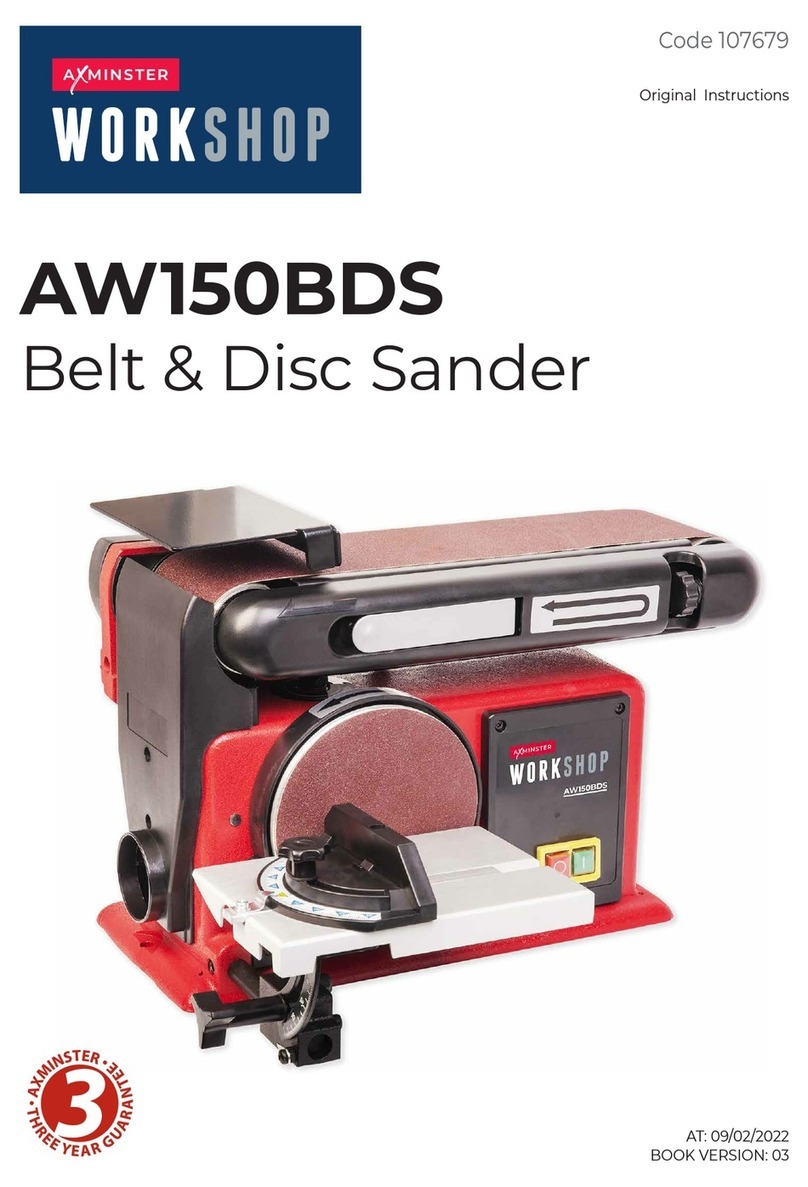
Axminster
Axminster WORKSHOP AW150BDS Original instructions

Westfalia
Westfalia 85 46 55 Original instructions

MIRKA
MIRKA AP 300NV operating instructions
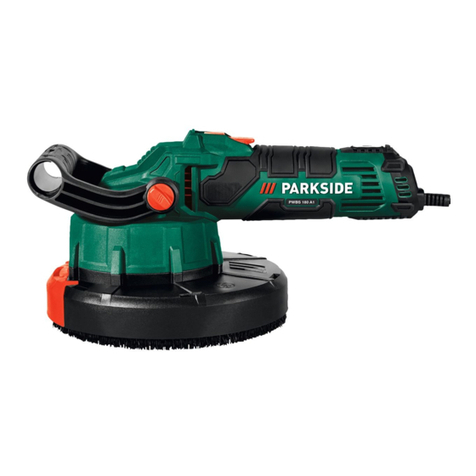
Parkside
Parkside PWBS 180 A1 Translation of the original instructions
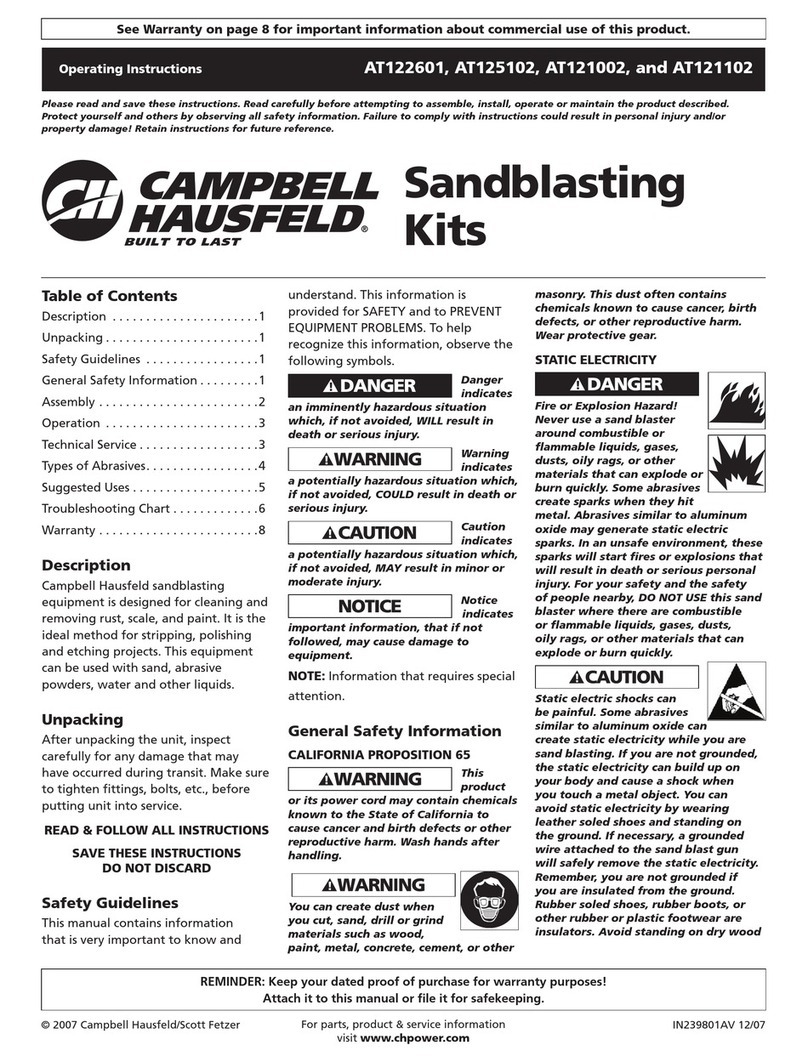
Campbell Hausfeld
Campbell Hausfeld AT122601 operating instructions
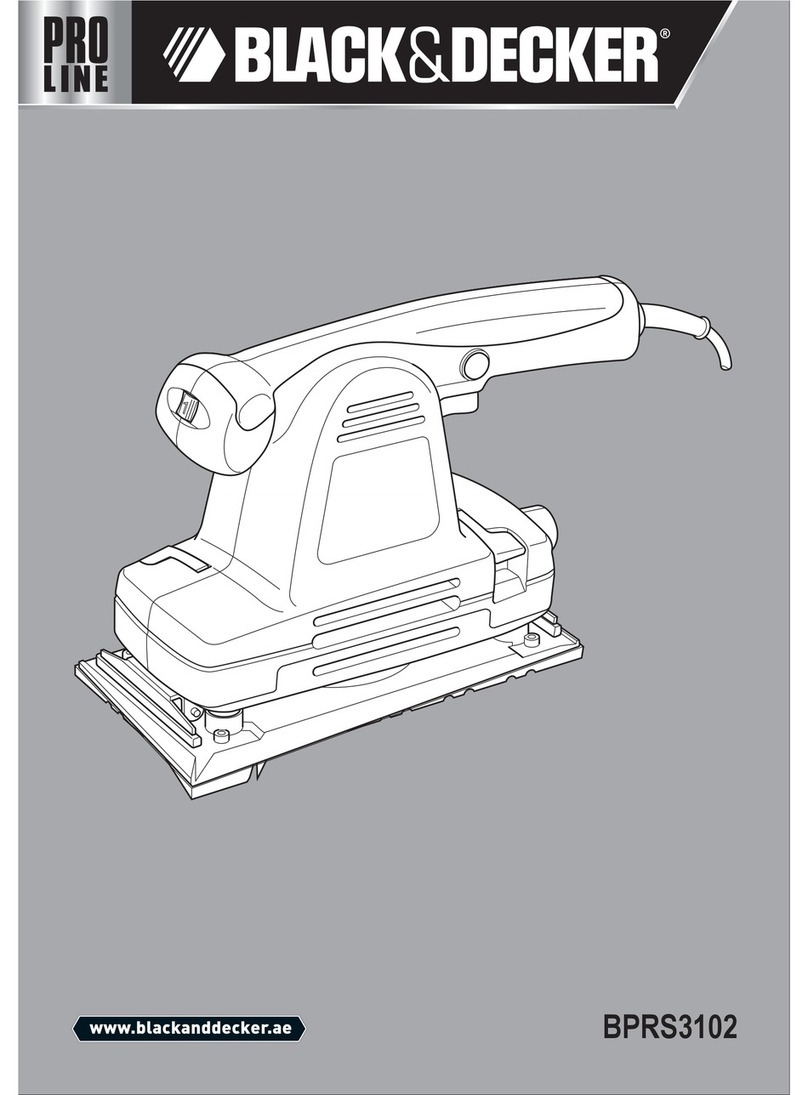
Black & Decker
Black & Decker BPRS3102 Pro Line Instruction guide

